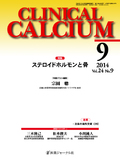Japanese
English
- 有料閲覧
- Abstract 文献概要
- 1ページ目 Look Inside
- 参考文献 Reference
合成グルココルチコイド(副腎皮質ステロイド薬)は,強力な抗炎症作用と免疫抑制作用から多くの疾患の治療に汎用され,約120万人以上がステロイド薬を3カ月以上使用する。ステロイド薬はコルチゾールと共通の核内受容体に結合して,骨代謝異常症,ステロイド性骨粗鬆症を生ずる。ステロイド薬は骨芽細胞や骨細胞にアポトーシスを誘導し,破骨細胞の細胞寿命を延長して,骨密度と骨微細構造を減衰して骨代謝異常,すなわち,骨粗鬆化を促進し,高い脆弱性骨折率を招く。ステロイド性骨粗鬆症は処方された薬剤による副作用であり,的確な管理と治療が必要である。
Glucocorticoid(GC)is widely used to treat a variety of inflammatory and allergic diseases and about one million people in Japan are known to take oral GC. GC causes a number of adverse effects and among them osteoporosis and degenerative bone fracture are major complications of GC therapy. GC induces apoptosis of osteoblasts and osteocytes and prolongs lifespan of osteoclast, resulting in low bone mass and microarchitectural deterioration of bone tissue, which leads to severe osteoporosis, increased bone fragility and susceptibility to bone fracture. Although GC-induced osteoporosis is the most common iatrogenic osteoporosis, few physicians fully manage it. Physicians who prescribe GC have to manage patients according to guidelines on the management and treatment of GC-induced osteoporosis, because recent multiple evidences strongly indicate that certain medication such as bisphosphonates is effective for treatment and prophylaxis of GC-induced osteoporosis.



